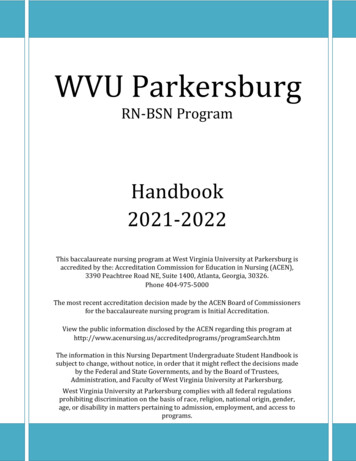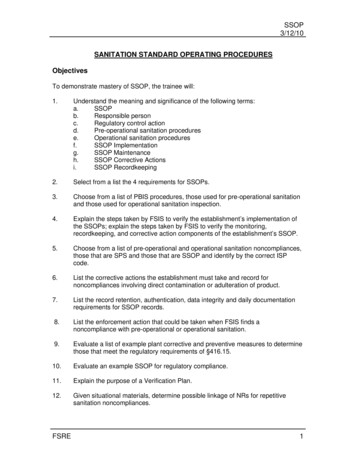
Transcription
WVU Standard Operating ProceduresFor theWest Virginia Early Defibrillation ProgramWest Virginia State Code-Chapter 16, Article 4DWest Virginia University – Environmental Health & SafetyOrigination Date: February 2010 Revised: April 11, 2017ehs.wvu.eduEarly Defibrillation SOPOriginator- Roger Wright
Table of Contents1. Purpose .12. Scope .13. Definitions .14. Responsibilities .24.1 Medical Director .24.2 Environmental Health and Safety .24.3 University Police Department .34.4 AED Program Coordinator(s) .35. Training .46. Procedures .56.1 Locating an AED .56.2 Selection .56.3 AED Placement .56.4 Registration and Notifications .66.5 Maintaining and Testing AEDs .76.6 Data Collection and Reporting.77. Recordkeeping .87.1 Record Retention .88. References .88.1 Regulations .89. AED Standard Operating Procedure Review .810. AED Standard Operating Procedure evisions .8Appendix A .9Appendix B .10West Virginia University – Environmental Health & SafetyOrigination Date: February 2010 Revised: April 11, 2017ehs.wvu.eduEarly Defibrillation SOPOriginator- Roger Wright
1. PurposeWest Virginia University (WVU) is dedicated to providing safe and healthful facilities for allemployees and students and complying with Federal and State occupational health and safetystandards. An Automated External Defibrillator (AED) in the workplace can greatly increase theperson’s chance of survival in the event of sudden cardiac arrest. This Standard OperatingProcedure (SOP) is designed to identify and designate responsibilities for the implementation ofthe West Virginia Early Defibrillation Program as outlined in the West Virginia State Code,Chapter 16, Article 4D.2. ScopeThis program covers University employees and areas where AEDs are located and madeavailable.3. DefinitionsAED Program Coordinator-the building or department on-site designated person responsiblefor overseeing the day-to-day activities of the program; assigned by the building supervisor ortheir designee.Anticipated operator-any person trained in accordance with Section 5 of this document whoutilizes an automated external defibrillator which was placed through the early defibrillationprogram.Automated external defibrillator (AED)-a medical device heart monitor and defibrillator that(1) has undergone the premarket approval process pursuant to the Federal Food, Drug andCosmetic Act, 21 U.S.C. §360, as amended; (2) is capable of recognizing the presence orabsence of ventricular fibrillation; (3) is capable of determining, without intervention by theoperator, whether defibrillation should be performed; and (4) upon determining thatdefibrillation should be performed, automatically charges and requests delivery of an electricalimpulse to an individual’s heart.WV Early Defibrillation Program-a coordinated program that meets the requirements of theWest Virginia State Code, Chapter 16, Article 4D and provides early public access todefibrillation for individuals experiencing sudden cardiac arrest through the use of anautomated external defibrillator.West Virginia University – Environmental Health & SafetyOrigination Date: February 2010 Revised: April 11, 2017ehs.wvu.eduEarly Defibrillation SOPOriginator- Roger WrightPage 1 of 10
Emergency medical services (EMS)-all services established by the Emergency Services Act of1973 in the West Virginia State Code, Chapter 16, Article 4C, including, but not limited to, theemergency medical services plan of the Department of Health and Human Resources whoprovides a response to the medical needs of an individual to prevent the loss of life oraggravation of illness or injury.Medical director-a duly licensed physician who serves as the designated medical coordinatorfor an entity’s early defibrillation program.Unanticipated operator-any person rendering emergency medical care involving the use of anAED.4. Responsibilities4.1 Medical DirectorMedical oversight is an important part of the AED program and involves the followingduties:1. WVU Occupational Medicine shall appoint a physician to serve as MedicalDirector of the WVU Early Defibrillation SOP.2. The Medical Director is responsible for signing the Office of EMS registrationapplication and reviews each AED Patient Contact Form.3. The Medical Director delegates the coordination of training, EMS integration,and AED deployment strategies to the AED Program Coordinator4. The Medical Director will review and update program requirements inconjunction with WVU Environmental Health and Safety.5. Send completed Patient Contact Form (See Appendix B Page 10) to the RegionalEMS Field Office located at 1829 Pleasant Valley Road, Fairmont, WV 26554.4.2 Environmental Health and SafetyThe duties of EHS include:1. Appoint WVU EHS AED contact;2. Assist with AED selection and placement;3. Document and maintain AED locations as received by departments incoordination with the WVU Police Department;4. Coordinate CPR/AED training;5. Track recordkeeping data;6. Communicate AED requests with department program coordinator.West Virginia University – Environmental Health & SafetyOrigination Date: February 2010 Revised: April 11, 2017ehs.wvu.eduEarly Defibrillation SOPOriginator- Roger WrightPage 2 of 10
4.3 University PoliceThe WVU University Police Department (UPD) will work with Environmental Health andSafety to document and maintain AED locations as received by departments. The UPDwill notify EHS in the event of AED usage.4.4 AED Program Coordinator(s)The program coordinator is the building or department on-site designated person(s)responsible for overseeing the day-to-day activities of the program. The programcoordinator will coordinate training with EHS, ensure EMS integration, and develop AEDdeployment strategies. The building supervisor or their equivalent is responsible forassigning the coordinator. Possible program coordinators are: building supervisors,departmental supervisors, safety committee members, or chemical hygiene officers.Please contact EHS if assistance is needed in selecting a coordinator. The duties of theprogram coordinator include:Prior to AED Purchase:1) Review the WV Office of EMS Early Defibrillation Program Registration Guidelinespacket in Appendix B.2) Coordinate with building supervisor regarding placement of AED;3) Consult with WVU Campus Planning and University Relations (Branding andMarketing) to obtain WVU standardized signage for AED.After AED Purchase:1) Place AED in an accessible location;2) Ensure all anticipated operators are aware of AED locations;3) Complete the AED registration for WVU found in Appendix A;4) Register the AED with WV Office of EMS Early Defibrillation Program RegistrationGuidelines packet in Appendix B. In order to complete the WV Early DefibrillationProgram, the following must be accomplished:1. The AED Program Coordinator completes the registration application (seeAppendix B Pages 7-9) and returns it to the Regional EMS Field Office located at1829 Pleasant Valley Road, Fairmont, WV 26554.2. The AED Program Coordinator obtains an American Red Cross (ARC) or AmericanHeart Association (AHA) course of instruction for each program provider/AEDoperator.3. The AED Program Coordinator prepares and administers the entity’s AEDmaintenance program (see manufacturer’s guidelines).4. The AED Program Coordinator retains the services of a licensed physician to bethe Early Defibrillation Program Medical Director. The Medical Director signs theWest Virginia University – Environmental Health & SafetyOrigination Date: February 2010 Revised: April 11, 2017ehs.wvu.eduEarly Defibrillation SOPOriginator- Roger WrightPage 3 of 10
entity’s registration application and reviews each AED patient contact. The AEDProgram Coordinator agrees to coordinate training, EMS integration, AEDdeployment strategies as delegated by the Medical Director. WVU OccupationalMedicine shall serve as the Medical Director of the WVU Early DefibrillationSOP. WVU Occupational Medicine can be contacted by calling 293-3693.5. The AED Program Coordinator confers with the local EMS agency and 911 centerto establish a brief written plan for notification of the EMS system in case of anAED patient contact (See Appendix B Page 9). This plan is to be submitted to theRegional EMS Field Office with the registration application. The addresses ofRegional EMS Field Offices can be found in Appendix B page 11.6. The AED Program Coordinator prepares the list of AED operators affiliated withthe entity including the operators’ training. This list is part of the entityregistration application submitted to the Regional EMS Field Office (Appendix BPage 8).4) Ensure AED is in proper working order;5) Maintain AED per manufacturer’s recommendations;6) Coordinate training with EHSAfter AED Usage:1) Notify:a) Medical Director appointed by WVU Occupational Medicine (304-293-3693)b) EHS AED Contact – (304-293-7094 or 304-293-5814)c) UPD (304-293-COPS)2. Complete and submit an AED Patient Contact Form (See Appendix B Page 10)whenever an AED operator uses the AED on a patient. The form is submitted to theMedical Director appointed by WVU Occupational Medicine.3. Follow manufacturer’s recommendations for servicing AED after use (such asreplacing pads).Notify EHS of removal or retirement of an AED from service.Training5.1 The West Virginia State Code requires that anticipated AED users complete trainingin cardiopulmonary resuscitation (CPR) and in the operation of an AED.5.2 Training must be provided by a nationally recognized program approved by the WVOffice of EMS, such as the American Red Cross or the American Heart Association.The approved American Red Cross course is:Adult CPR/AED training CourseWest Virginia University – Environmental Health & SafetyOrigination Date: February 2010 Revised: April 11, 2017ehs.wvu.eduEarly Defibrillation SOPOriginator- Roger WrightPage 4 of 10
The approved American Heart Association courses are:Heartsaver AED (with skills-station and exam)Heartsaver FACTSHealthcare Provider (with AED module and exam)ACLS Provider CourseACLS Instructor Course5.3 Contact EHS at 304-293-7094 to schedule training. First Aid/CPR/AED training datesand registration information can be found on the EHS website d-monthly-schedule5.4 All departmental personnel trained in First Aid/CPR/AED should be documented onPage 8 of Appendix B.6. Procedures6.1 Locating an AEDA complete list of AEDs on WVU campuses can be found at: https://goo.gl/B1duxw6.2 SelectionThere are many readily available types of AEDs that are suitable for workplace use. Keyfeatures should include:1.2.3.4.5.6.7.Lightweight and portable;Easy to use, safe, and effective;Automatically analyzes heart rhythms;Determines whether defibrillation is advised;Guides the user through defibrillation;Self-checking protocols; andPrompts the rescuer to begin CPR.6.3 AED PlacementAEDs are most effective when they can deliver a shock within 3 to 5 minutes after aperson collapses. When deciding where to place an AED, use a 3 minute response timeas a guide.1. AEDs need to be visible and easily identifiable.West Virginia University – Environmental Health & SafetyOrigination Date: February 2010 Revised: April 11, 2017ehs.wvu.eduEarly Defibrillation SOPOriginator- Roger WrightPage 5 of 10
2. Signage must follow WVU requirements found db10-d3d4-4bb1-9502b47341671b84/101410.pdfa. Signage should include the contact information of the AED programcoordinator in the event of AED maintenance issues and after AED usage.b. UPD contact information should also be included.3. Reception areas, walls of main corridors, cafeterias, and near elevators may beideal places for AEDs.4. Registration of the actual location of each AED is to be completed on the linkprovided in Appendix A.6.4 Registration and NotificationsAll WVU department AED program coordinators must adhere to the requirements ofthe attached WV Early Defibrillation program and complete the documentation foundin Appendix B pages 7-9. See section 4.4 for details. Send the completeddocumentation to:1.2.3.4.WV Office of EMSLocal 911Local EMSEHSIn order to complete the WV Early Defibrillation Program, the following must beaccomplished:1. The AED Program Coordinator completes the enclosed application (see Appendix BPages 7-9) and returns it to the Regional EMS Field Office. See Appendix B Page 11 forthe list of Regional Field Offices. The regional office for Monongalia County is located at1829 Pleasant Valley Road, Fairmont, WV 26554.2. The AED Program Coordinator obtains an American Red Cross (ARC) or AmericanHeart Association (AHA) course of instruction for each program provider/AED operator.3. The AED Program Coordinator prepares and administers the entity’s AEDmaintenance program (see manufacturer’s guidelines).4. The AED Program Coordinator retains the services of a licensed physician to be theEarly Defibrillation Program Medical Director. The Medical Director signs the entity’sregistration application and reviews each AED patient contact. The AED ProgramCoordinator agrees to coordinate training, EMS integration, AED deployment strategiesWest Virginia University – Environmental Health & SafetyOrigination Date: February 2010 Revised: April 11, 2017ehs.wvu.eduEarly Defibrillation SOPOriginator- Roger WrightPage 6 of 10
as delegated by the Medical Director. WVU Occupational Medicine shall serve as theMedical Director of the WVU Early Defibrillation SOP. WVU Occupational Medicinecan be contacted by calling 293-3693.5. The AED Program Coordinator confers with the local EMS agency and 911 center toestablish a brief written plan for notification of the EMS system in case of an AEDpatient contact. This plan is to be submitted to the Regional EMS Field Office with theregistration application. (See Appendix B Pages 9).6. The AED Program Coordinator prepares the list of AED operators affiliated with theentity including the operators’ training. This list is part of the entity registrationapplication submitted to the Regional EMS Field Office. (See Appendix B Page 8).7. The Program’s Official Representative completes and submits an AED Patient ContactForm whenever an AED operator uses the AED on a patient (see Appendix B Page 10).6.5 Maintaining and Testing AEDsAEDs must be maintained and tested in accordance with the manufacturer’s guidelines.Written records of maintenance and testing must be kept by the AED programcoordinator or another designated person. The costs associated with maintaining theAED such as replacing pads and batteries are the responsibility of the Department.A checklist will be used to assess the readiness of AEDs and their supplies. Use themaintenance checklist found in the AED operating manual as a guide. Originalcompleted maintenance checks shall be kept on file with the Program Coordinator.6.6 Data Collection and ReportingWest Virginia State Law requires AED use to be reported to the WV Office of EMS. Toensure this reporting occurs, follow the steps below after AED use:1. Contact EHS (304-293-7094 or 304-293-5814) immediately after an AEDincident or within 24 hours.2. EHS will notify WVU Occupational Medicine (304-293-3693) immediatelyupon notification of incident, or as soon as possible.3. Complete the appropriate paperwork, forward it to the medical director,who will deliver it to the regional WV Office of EMS (Appendix B page 10).NOTICE: Call 911 immediately if someone is experiencing a cardiac emergency, thenprovide appropriate care. If the AED is used, the program coordinator will notifyEHS/UPD at 304-293-3792 or ehs.wvu.edu immediately after incident within 24 hours.West Virginia University – Environmental Health & SafetyOrigination Date: February 2010 Revised: April 11, 2017ehs.wvu.eduEarly Defibrillation SOPOriginator- Roger WrightPage 7 of 10
7. Recordkeeping7.1 Record Retention1. Training – records of all training provided, per Section 5 of this document, will bemaintained on file at EHS for the length of the individual’s employment plus aminimum of 30 years.2. Maintenance Checklists – records of the maintenance checklists performed permanufacturer’s guidelines will be kept on file with the AED Program Coordinatorof the department in ownership for a minimum of 3 years.3. Location/Number of AEDs – EHS will maintain a record of the location andnumber of all AEDs on WVU campuses.8. References8.1 Regulations1. West Virginia State Code, Chapter 16, Article 4D2. Federal Food, Drug and Cosmetic Act, 21 U.S.C. §3603. West Virginia EMS Early Defibrillation Registration Guidelines9. AED Standard Operating Procedure ReviewThe Early Defibrillation SOP will be reviewed as necessary by the University Police Department,Environmental Health and Safety and WVU Occupational Medicine. The SOP will be updatedand changed as needed in response to concerns of management, employees, or changes tocode regulations.10. AED Standard Operating Procedure RevisionsExplanation of Change – Any revisions to the Early Defibrillation SOP will include an explanationfor the change needed and how it will affect the current adopted SOP.Changes from Last Revision – Changes to the current Early Defibrillation SOP will includechanges from the last revision.West Virginia University – Environmental Health & SafetyOrigination Date: February 2010 Revised: April 11, 2017ehs.wvu.eduEarly Defibrillation SOPOriginator- Roger WrightPage 8 of 10
Appendix ALink to Register an AED with WVU:West Virginia University – Environmental Health & SafetyOrigination Date: February 2010 Revised: April 11, 2017ehs.wvu.eduhttps://goo.gl/Zx5q4EEarly Defibrillation SOPOriginator- Roger WrightPage 9 of 10
Appendix BWest Virginia Early Defibrillation Program Registration Guidelineshttp://www.wvoems.org/media/319120/early defibrillation program01272017.pdfWest Virginia University – Environmental Health & SafetyOrigination Date: February 2010 Revised: April 11, 2017ehs.wvu.eduEarly Defibrillation SOPOriginator- Roger WrightPage 10 of 10
Early Defibrillation ProgramRegistration GuidelinesWest Virginia Department ofHealth and Human ResourcesBureau for Public HealthOffice of Emergency Medical ServicesWVOEMS02/07/00
Table of ContentsIntroduction . . . . . . . . . . . . . . . . . . . . . . . . . . . . . . . . . . . . . . . . . . . . . . . . . . . . . . . . . -1Purpose . . . . . . . . . . . . . . . . . . . . . . . . . . . . . . . . . . . . . . . . . . . . . . . . . . . . . . . . . . . -1Program Requirements . . . . . . . . . . . . . . . . . . . . . . . . . . . . . . . . . . . . . . . . . . . . . . . . -2How To Meet Program Requirements . . . . . . . . . . . . . . . . . . . . . . . . . . . . . . . . . . . . -3How Does Being Compliant Help? . . . . . . . . . . . . . . . . . . . . . . . . . . . . . . . . . . . . . . . -4What Can’t You Do? . . . . . . . . . . . . . . . . . . . . . . . . . . . . . . . . . . . . . . . . . . . . . . . . . . -5Approved Training Courses . . . . . . . . . . . . . . . . . . . . . . . . . . . . . . . . . . . . . . . . . . . . -6Training Contacts . . . . . . . . . . . . . . . . . . . . . . . . . . . . . . . . . . . . . . . . . . . . . . . . . . . . -6Early Defibrillation Program Registration Application . . . . . . . . . . . . . . . . . . . . . . . . . -7Early Defibrillation Program Operator Roster . . . . . . . . . . . . . . . . . . . . . . . . . . . . . . . -8Early Defibrillation EMS Integration Sample Plan . . . . . . . . . . . . . . . . . . . . . . . . . . . . -9Early Defibrillation Patient Contact Form . . . . . . . . . . . . . . . . . . . . . . . . . . . . . . . . . -10TSN Regional EMS Field Offices . . . . . . . . . . . . . . . . . . . . . . . . . . . . . . . . . . . . . . . -11House Bill 2269 . . . . . . . . . . . . . . . . . . . . . . . . . . . . . . . . . . . . . . . . . . . . . . . . . . . . -12-02/07/00Early Defibrillation Program Registration.wpd
IntroductionDuring the 1999 Legislative Session, House Bill 2269 was passed, amendingChapter 16 Article 4C of the West Virginia State Code, authorizing the West Virginia Officeof Emergency Medical Services to “register early defibrillation programs”. Working inpartnership with the American Heart Association, American Red Cross, EMS, fire fighting,and law enforcement communities, the Legislation established definitions and criteria forentities providing early defibrillation programs including training, medical direction,protocols, and notification of local EMS systems.PurposeThe 1999 Legislature agreed with the scientific findings of the American HeartAssociation and others that as many as 250,000 Americans each year suffer from out-ofhospital sudden cardiac arrest. The medical/scientific community believes that 95% ofthese incidents result in death, and many of these deaths can be prevented if properlytrained individuals could provide early automatic external defibrillation.The Legislature felt very strongly that communities have invested significantly inenhanced 911 and emergency medical services systems. They indicated that earlydefibrillation programs had to meet certain standards and be coordinated with local 911and EMS systems.02/07/00Early Defibrillation Program Registration.wpd-1-
Program RequirementsThe Legislation requires that “an entity providing an early defibrillation programshall”:1.Register the program with the Office of Emergency Medical Services,pursuant to article four-c of this chapter, identifying the placement of AEDs,training of AED operators, preplanned EMS system coordination, designationof a medical director, maintenance of AED equipment and reports of AEDutilization;2.Require the operator of an AED to receive appropriate training incardiopulmonary resuscitation, referred to as “CPR”, in the operation of anAED and in the determination of advance directives from the American HeartAssociation, American Red Cross, any other nationally recognized course inCPR and AED, or an AED and CPR training program approved by the Officeof Emergency Medical Services;3.Maintain and test the AED in accordance with the manufacturer’s guidelines,and keep written records of this maintenance and testing;4.Designate a medical director for the coordination of the program, which shallinclude, but not be limited to, training, coordinating with EMS, creating AEDdeployment strategies and reviewing each operation of an AED;5.Notify the local EMS system and public safety answering point or otherappropriate emergency dispatch center of the existence of an entity’s earlydefibrillation program, the location of the program and the program’s plan forcoordination with the EMS system;6.Provide that an operator of an AED who renders emergency care ortreatment on a person experiencing cardiac arrest shall activate the EMSsystem as soon as possible and shall report the use of an AED to theprogram medical director; and7.Comply with the guidelines of the West Virginia Office of Emergency MedicalServices regarding data collection and reporting.02/07/00Early Defibrillation Program Registration.wpd-2-
How To Meet Program Requirements1.The Program’s Official Representative completes the enclosed application(page 7) and returns it to the Regional EMS Field Office (see map of fieldoffice locations).2.The Program’s Official Representative obtains an American Red Cross(ARC) or American Heart Association (AHA) course of instruction for eachprogram provider/AED operator (see list of courses and contacts for ARCand AHA).3.The Program’s Official Representative prepares and administers the entity’sAED maintenance program (see manufacturer’s guidelines).4.The Program’s Official Representative retains the services of a licensedphysician to be the Early Defibrillation Program Medical Director. Thisindividual signs the entity’s registration application and agrees to coordinatetraining, EMS integration, AED deployment strategies, and reviews eachAED patient contact.5.The Program’s Official Representative confers with the local EMS agencyand 911 center to establish a brief written plan for notification of the EMSsystem in case of an AED patient contact. This plan is to be submitted to theRegional EMS Field Office with the registration application (a sample plancan be found on page 9).6.The Program’s Official Representative prepares the list of AED operatorsaffiliated with the entity including the operators’ training. This list is part ofthe entity registration application submitted to the Regional EMS Field Office.7.The Program’s Official Representative completes and submits an AEDPatient Contact Form whenever an AED operator uses the AED on a patient(submit the form as specified).02/07/00Early Defibrillation Program Registration.wpd-3-
How Does Being Compliant Help?1.Being compliant with the provisions for an early defibrillation program:a.Means you are lawfully performing a vital function for your community;b.According to the Automated External Defibrillator section of Chapter 16Article 4D, you as an AED provider are “not liable for civil damages as aresult of any act or omission in rendering emergency medical care ortreatment involving the use of an AED if the care or treatment does notamount to gross negligence, and the following conditions are met:1.The person, entity, certified trainer or medical director of the earlydefibrillation program is in compliance with the provisions of sectionthree of this article, and;2.The person is an operator of an AED who gratuitously and in goodfaith rendered emergency medical care, pursuant to the requirementsof section three of this article, other than in the ordinary course of theperson’s employment or profession.”Note: “Section three of this article” refers to the actual legislation in code.c.Means you are supporting your local 911 center and EMS system byinvolving them in your planning and operations.d.Means you are giving your program medical accountability and credibility byobtaining a physician medical director.e.Means you are guiding the future of AED use in the state by filling out andmailing the Patient Contact Forms when you operate an AED with a patient.This data will allow researchers to determine trends on deploymentstrategies, program viability, patient response, etc.02/07/00Early Defibrillation Program Registration.wpd-4-
What Can’t You Do?1.You can’t respond with an AED off-site to provide this service unless you are alicensed EMS agency or have an Affiliation Agreement with a licensed EMS agency.Early defibrillation programs are established for use on-site and should be placedin a central location. Vehicles used on-site, i.e., a coal mine or industrial facility maybe used to transport the AED for use elsewhere on the site.Site examples are:a.b.c.d.e.f.g.2.Sports ComplexesChurchesIndustrial Sites/Coal MinesSchoolsCommunity Swimming PoolsRetail StoresOthers as agreed uponAn individual responder cannot provide medical assistance above the level ofhis/her training, certification or professional license, and the regulations associatedwith such training, certification or professional license.02/07/00Early Defibrillation Program Registration.wpd-5-
Approved Training CoursesThe Office of EMS ha
WVU Occupational Medicine shall serve as the Medical Director of the WVU Early Defibrillation SOP. WVU Occupational Medicine can be contacted by calling 293-3693. 5. The AED Program Coordinator confers with the local EMS agency and 911 center to establish a brief written plan for notification of the EMS system in case of an AED patient contact (See










